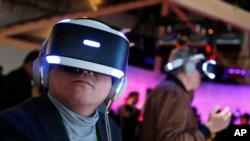"We think it's the right time to offer a new, more technologically advanced headset, based on feedback from our first model," said Nathalie Dacquin, marketing director for PlayStation in France.
The SONY PS VR2 certainly improves on its predecessor -- it is lighter and displays finer and more fluid images.
But one aspect of the Sony gadget that will not revolutionise the market is the price -- weighing in at $550.
Two of the flagship models currently on the market, the Quest 2 by Meta and the PICO 4, are priced at around $400.
And the PICO 4, developed by ByteDance, the Chinese owner of TikTok, is unavailable in the United States.
But what Sony has over the competition is the PlayStation, and roughly 30 games will be compatible with the new headset, including the racing simulator "Gran Turismo 7".
"These are obviously the games that will make the headset a success," Dacquin said.
But experts are not seeing a revolution quite yet.
More companies with products in different price brackets could help to shake up the market in the longer term, said Rick Kowalski of the Consumer Technology Association (CTA), which organizes the Consumer Electronics Show [CES] tech exhibition in Las Vegas.
"Competition and economies of scale tend to bring prices down over time," he said.
But there are still plenty of barriers to a wider uptake.
Rolf Illenberger of VRDirect, a consulting firm, said technology advances make the devices outdated at a rapid pace.
Customers who buy flashy headsets "tend to be quite disappointed" when they find out a few months later that a new generation is already out and their version is no longer properly supported, he said.
He reckons the headsets are still best deployed in technical and corporate settings.
"Aside from gaming, it does not yet offer a sufficient content lineup for people to be attracted to this technology on a regular basis," he said.
